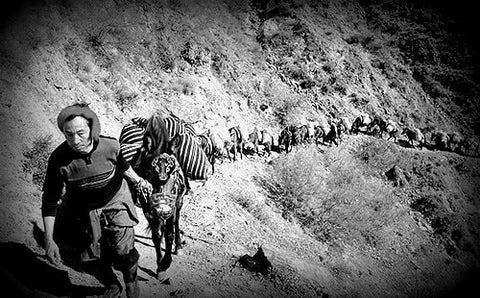What is Puerh Exactly? September 09 2013
In my first blog I talked about what puerh was in broad strokes, my introduction to puerh, and more importantly what puerh means to me. In this blog I hope to outline what puerh is specifically, what the history of puerh is, where it comes from, and how it is made. Obviously, this blog post is intended to be read by those with a knowledge of puerh that is limited or non existent. My audience is the person I was last year. The person who desperately wants to know what puerh is but doesn’t know they want to know what it is yet. I want to reach that person.
If you’ve only just begun hearing about puerh tea, you might think it’s some new trend or brand. You would be partially correct. Puerh is definitely a growing trend outside of Asia. However, puerh has been around for many hundreds of years. Somewhere around 1300 years ago puerh tea was created by accident. You could describe puerh as magic and not face serious debate to the contrary. Personally, I love how Ip Wing Chi describes puerh: “Pu-Erh tea is actually a stroke of genius from the tea farmer, not something ordinary research can fully explain.”
In the southwestern corner of China, at the borders of Laos, Burma, and Vietnam, is the province of Yunnan. Yunnan is the evolutionary home to all of the worlds tea trees. The original tea trees, Camellia sinensis, originated in the jungle mountains at the foothills of the Himalayas. There are trees there now that have been growing and producing leaves for tea for more than a thousand years. Puerh harvested from trees hundreds of years old is quite common. For the right price that is. My American mindset balks at the idea that I am drinking something from a tree that was planted before America was a country. I have no modern reference for age of that scale. It still blows my mind.

These leaves are most likely from trees planted when Christopher Columbus was alive. Wait what?! © Crimson Lotus Tea
Tea production has been a part of life in Yunnan since the time of the Pharaohs in Egypt. Export was traditionally performed along the Ancient Tea Horse Road. This trade route wound through the mountains from Yunnan and into India, Tibet, and central China. It was named the Tea Horse Road because Yunnan tea was traded for Tibetan horses. Actually they were ponies, but Tea Pony Road didn’t have the same ring to it. Until last century the Ancient Tea Horse Road was used continuously since the Tang Dynasty which was from 618–907 AD. This road spanned more than a thousand miles and was quite a difficult journey to undertake. Delivery of tea could easily take as long as a year. The journey was rough and often hot and humid.
It was on this road that puerh tea was born, as the story goes. The tea was harvested in Yunnan, processed as green tea, and packed tight to allow as much tea to be transported as man and beast could carry. The heat and humidity of the long journey on the Tea Horse Road changed the tea. A bacteriological process began a fungal fermentation in the tea leaves. After arrival at the destination it was noticed that the tea had changed. Some thought the tea had spoiled, but enough others found the new creation tasty and puerh was born. Particulars on the exact details are surely lost to time.

Ancient Tea Horse Road © Sichuan Provincial Tourism Bureau
In our modern tea age, puerh is created intentionally after the leaves are picked. The leaves are sun dried to remove moisture and then partially fried in a large wok. The process differentiates itself from green tea at this stage. Green tea would be dried with hot air to prevent further oxidation. Puerh is allowed to dry in the sun and thus fermentation can continue. Because of the care taken in processing, puerh is allowed to ferment and age long after it is sold at market. Like wine it can continue to age for many decades. The microorganisms cultivated in Yunnan continue to change the leaf improving the flavor with time. Puerh is alive!
Similar to wine, the Chinese government has taken additional steps to protect the name puerh and only allows leaves harvested in Yunnan to carry the name puerh. Puerh can be further broken down into two main categories; raw / green and ripe / cooked / red. Those differences I will outline in a different blog. Given that the flavor of puerh ages with time, and taking into consideration differing quality in weather and harvesting from year to year, differences in processing and storage, pinpointing a single taste to puerh is not possible. That’s a good thing! Exploring the amazing world of puerh can be a delicious adventure.
Given the probiotic nature of puerh there are numerous health benefits. I enjoy puerh for the flavor, but it doesn’t hurt that it is also beneficial to my health. Puerh drank after heavy meals can help break down the fats and aid in digestion. It is used to lower blood pressure, reduce cholesterol, aid in weight loss, and is full of antioxidants. It is also claimed to be a handy hangover remedy, although I am past the time in my life where I drink enough to experience hangovers, I don’t doubt the claim. Drink it for the flavor or for the health benefits.
If you’ve never tried puerh before and are in the Seattle area stop by for a tea tasting. [ crimsonlotustea@gmail.com ] If not try to find a ripe puerh around 5 years old and give it a try. I find that first time puerh drinkers prefer ripe puerh. Raw puerh has amazing flavor possibilities, but ripe puerh is more mellow and seems more suited to a western palate in my experience. Enjoy exploring puerh!
